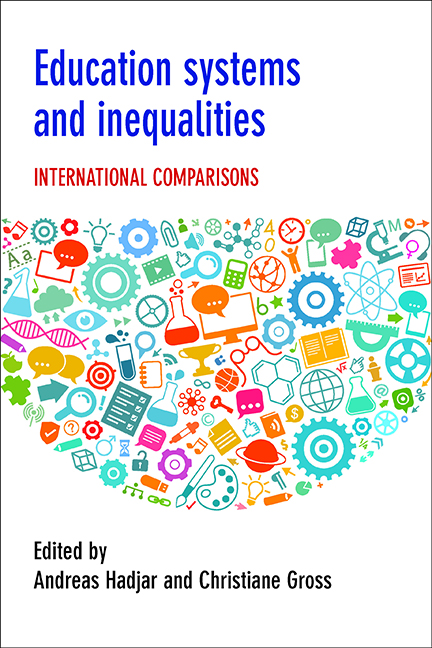Book contents
- Frontmatter
- Contents
- List of tables and figures
- Notes on contributors
- Acknowledgements
- Introduction: education systems and inequalities
- one Theorising the impact of education systems on inequalities
- two Comparing education policies in a globalising world: methodological reflections
- three Education systems and intersectionality
- four Measuring educational institutional diversity: tracking, vocational orientation and standardisation
- five Sorting and (much) more: prior ability, school effects and the impact of ability tracking on educational inequalities in achievement
- six Data analysis techniques to model the effects of education systems on educational inequalities
- seven Education systems and inequality based on social origins: the impact of school expansion and design
- eight Education systems and gender inequalities in educational attainment
- nine Tracking, school entrance requirements and the educational performance of migrant students
- ten From exclusion and segregation to inclusion? Dis/ability-based inequalities in the education systems of Germany and Nigeria
- eleven Education systems and meritocracy: social origin, educational and status attainment
- twelve Education systems and gender inequalities in educational returns
- thirteen Education systems and migrant-specific labour market returns
- fourteen Health returns on education and educational systems
- fifteen Good and bad education systems: is there an ideal?
- Conclusions and summary
- Index
nine - Tracking, school entrance requirements and the educational performance of migrant students
Published online by Cambridge University Press: 05 April 2022
- Frontmatter
- Contents
- List of tables and figures
- Notes on contributors
- Acknowledgements
- Introduction: education systems and inequalities
- one Theorising the impact of education systems on inequalities
- two Comparing education policies in a globalising world: methodological reflections
- three Education systems and intersectionality
- four Measuring educational institutional diversity: tracking, vocational orientation and standardisation
- five Sorting and (much) more: prior ability, school effects and the impact of ability tracking on educational inequalities in achievement
- six Data analysis techniques to model the effects of education systems on educational inequalities
- seven Education systems and inequality based on social origins: the impact of school expansion and design
- eight Education systems and gender inequalities in educational attainment
- nine Tracking, school entrance requirements and the educational performance of migrant students
- ten From exclusion and segregation to inclusion? Dis/ability-based inequalities in the education systems of Germany and Nigeria
- eleven Education systems and meritocracy: social origin, educational and status attainment
- twelve Education systems and gender inequalities in educational returns
- thirteen Education systems and migrant-specific labour market returns
- fourteen Health returns on education and educational systems
- fifteen Good and bad education systems: is there an ideal?
- Conclusions and summary
- Index
Summary
Introduction
The low educational achievement level of migrant students in most Western countries is a growing concern for policy makers. High educational achievement is a prerequisite for successful integration into society and thus the best strategy to combat societal exclusion and discrimination of minority groups. Many studies (for example, Portes and Rumbaut, 2001; OECD, 2012) have shown that the low educational achievement of migrant students is partly explained by their lower socioeconomic status, but even controlling for this, research still suggests a wide gap between native and migrant students in educational achievement. What is interesting from a policy perspective is that there is substantial variation among migrant students themselves. This variation is linked to, for instance, individual characteristics such as the student's destination language, whether the student is a first- or second-generation migrant, age of migration, and having one or two non-native parents (Chiswick and Miller, 1996, 2002).
This study focuses on the effects of certain education system characteristics on migrant student performance. A study by the Organisation for Economic Co-operation and Development (OECD, 2007) showed that the more differentiated a country's education system, the more native students outperform migrant students, even after taking into account social background characteristics. Ammermuller (2005), who used a more restricted measurement of differentiation (number of school types available), reached another conclusion: the more types of school from which migrant students can choose in secondary education, the better they perform on average. Such a school system, however, with choices between different school types, enhances the negative effect of speaking the language of the country of origin at home.
Although these studies examine the effects of education systems on migrants, this is not the main focus of their analysis. They also lack a suitable design to study the effects of a migrant's country of origin and destination, and these are related to their educational achievement. This chapter builds on the work of Levels et al (2008) and Dronkers et al (2014), who focused on the influence of both societal and education system characteristics of a migrant's country of origin and destination on their educational achievement. These studies use the cross-classified multi-level design first introduced by van Tubergen et al (2004). Instead of relying on observations of multiple-origin groups in a single destination, or a single-origin group in multiple destinations, the authors proposed a combined method that allows the comparison of multiple origins in multiple destinations.
- Type
- Chapter
- Information
- Education Systems and InequalitiesInternational Comparisons, pp. 185 - 206Publisher: Bristol University PressPrint publication year: 2016



